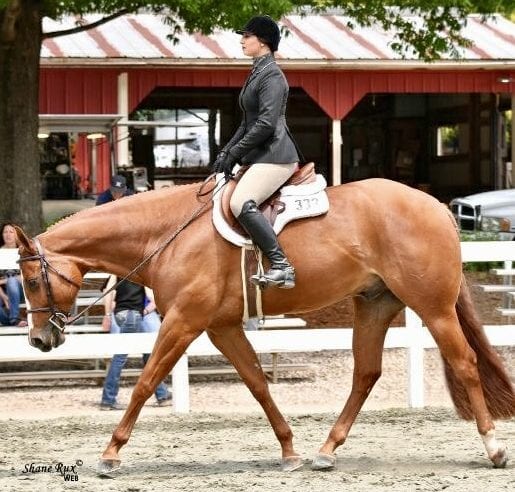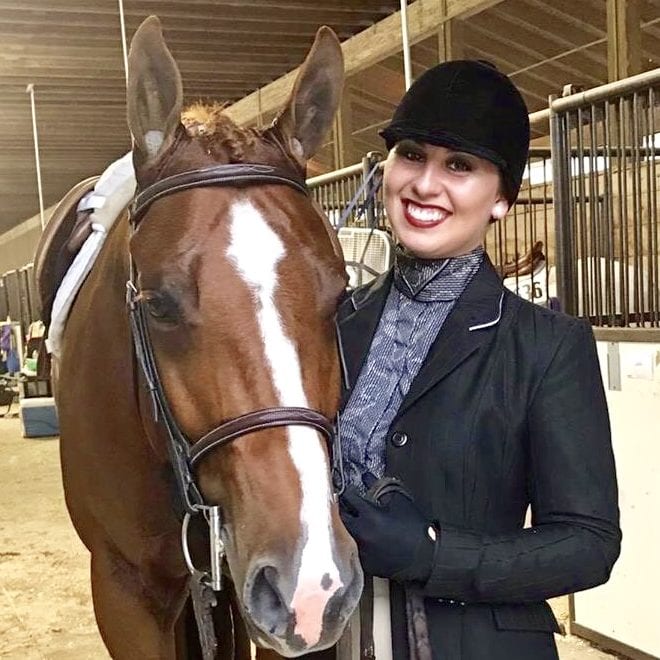Editor’s Note: GoHorseShow writer and AQHA amateur competitor, Morgan McCarthy-Warda, discusses tips on how she uses visualization techniques to perform the best possible patterns with her horses. We thought it would be unique to get the insight from a rider who still competes in the pattern classes at every show. Read her invaluable advice below.
Pattern classes test skill, maneuverability, partnership, and technicality. They have quickly become exhibitor favorites and a necessity for anyone interested in competing in the all-around. Perfecting patterns takes time. Not only are you controlling your horse’s body movements, but you must also do so while holding yourself in a proper and quiet position.
The mechanical part of pattern work plays a role in successful completion, but if an exhibitor focuses solely on ‘going through the motions,’ they will lose some of the most critical steps in the process. Being able to visualize the task ahead is a part of that process and can make or break the results. You have to know where you are going before you get there.
The moment you read a pattern, the process begins. Here are five steps to visualization in the show arena.
Watch and Learn
 Judges pick or design patterns based on what degree of difficulty they want to see performed. Every pattern will have at least one maneuver that is built to separate people and their abilities. As a horseman, you should become familiar with recognizing three things: your strengths, your weaknesses, and the elements that a judge is going to be focused on the most. These ideas will help you begin your visualization process.
Judges pick or design patterns based on what degree of difficulty they want to see performed. Every pattern will have at least one maneuver that is built to separate people and their abilities. As a horseman, you should become familiar with recognizing three things: your strengths, your weaknesses, and the elements that a judge is going to be focused on the most. These ideas will help you begin your visualization process.
Identifying all of these things will allow you to decide what you can show off during a pattern, and what element(s) you need to focus on the most before showing. This could be hitting the mark in showmanship, transitions up and down to different gaits, etc.
A good way to start is to envision the pattern is to watch other classes. Take some time to pay attention to how exhibitors are completing the pattern and then how they place. All judges have different opinions, but it would give you a good starting point for comparisons and making decisions on how you would display pattern work.
Awareness
 Being aware of your horse’s skill set contributes to the success of a pattern. Some green horses need a little extra room to respond to cues before they react. As a rider, you should know this before entering the arena. Make sure you see how the pattern is set before your class and decide how far away you need to be from cones when asking for your transitions.
Being aware of your horse’s skill set contributes to the success of a pattern. Some green horses need a little extra room to respond to cues before they react. As a rider, you should know this before entering the arena. Make sure you see how the pattern is set before your class and decide how far away you need to be from cones when asking for your transitions.
For example: If your horse is not at a point where the departures are consistent, you won’t want to wait until the horse’s nose is at the cone to ask for that transition. Giving yourself a chance to see how the pattern is set in the show arena will help you make those decisions and adjust accordingly. Don’t just walk into your class without a plan. Use what you see from other people to manage help you decide what you do and don’t like. If you are first, use your best judgment based on how well you know your horse and the way it guides through a pattern.
Understanding the ‘How’
 An exercise that I have used myself and seen it work for many riders and showmen, especially those new to patterns, is a talk through. This doesn’t just mean repeating the pattern; it involves planning where you are going to ask for something and how you are going to ask for it – cues and all.
An exercise that I have used myself and seen it work for many riders and showmen, especially those new to patterns, is a talk through. This doesn’t just mean repeating the pattern; it involves planning where you are going to ask for something and how you are going to ask for it – cues and all.
It sounds like a lot to discuss for a short pattern but making a pattern a series of events will help you transition smoothly from one element to the next. The way you cue and steer through one part of the pattern can affect the outcome of another. Mentally preparing for every stride of the pattern is a form of proactive planning in the visualization process – even if it’s about physical elements.
Landmarks
 Arena landmarks are one of the most valuable visual aids when planning and executing a pattern. A landmark could be anything from a line on the wall, a particular fence post, a poster, or anything that could be used to mark a position. When a pattern is set, one of the first things you should identify is the center point. In many patterns, this is a mark you will have to guide to and from many times. The following maneuvers are also critical and common elements that you can use landmarks.
Arena landmarks are one of the most valuable visual aids when planning and executing a pattern. A landmark could be anything from a line on the wall, a particular fence post, a poster, or anything that could be used to mark a position. When a pattern is set, one of the first things you should identify is the center point. In many patterns, this is a mark you will have to guide to and from many times. The following maneuvers are also critical and common elements that you can use landmarks.
Circles: On of the most common problems when riding a pattern with multiple circles is not making them even in size (unless otherwise called for). When I have circles in a pattern, I make a decision on the size they should be, and then, I find something along the wall to steer towards. In  many cases, this is a gate or fence post that marks the size I want to make my circle. Using that visual aid, I can drive my horse towards that space and know that I am using it wisely. If a pattern has more than one circle that is supposed to be the same size, or lines coming off of a circle, I find a point across the arena to mirror my first mark. This method is a way to ensure that the layout of your pattern is precise.
many cases, this is a gate or fence post that marks the size I want to make my circle. Using that visual aid, I can drive my horse towards that space and know that I am using it wisely. If a pattern has more than one circle that is supposed to be the same size, or lines coming off of a circle, I find a point across the arena to mirror my first mark. This method is a way to ensure that the layout of your pattern is precise.
Straight lines: If you want to make an impression, make a straight line. This element may seem straightforward, but it can be a distracting element if done incorrectly. The easiest way to complete a straight line is to pick a point out in front of you and always look ahead, so you come back to it every time. When it comes to patterns, vision is 90% of the recipe.
Envision Perfection
 People rarely have a completely perfect pattern, but you have to believe you can for it to be attainable. You know what it should look like, so make it happen in your mind. As you approach the start cone, run through the pattern and picture it with flawless execution instead of approaching the pattern in fear of the difficult elements. If you are worried about something before you even begin, you are setting yourself up to fail.
People rarely have a completely perfect pattern, but you have to believe you can for it to be attainable. You know what it should look like, so make it happen in your mind. As you approach the start cone, run through the pattern and picture it with flawless execution instead of approaching the pattern in fear of the difficult elements. If you are worried about something before you even begin, you are setting yourself up to fail.
This is the time to put everything together; your cues, layout, and landmarks. If all of those things come together, so will your pattern.
*****
Patterns are a real test of horsemanship in every discipline. It tests your ability to balance multiple different tasks while sitting correctly and maintaining a connection with your horse. All of the above must happen simultaneously for a successful ride. Your goal should be to solidify your position to the point where it is second nature to you. Muscle memory speaks volumes and gives you fewer things to think about when you should be focusing on the pattern that is laid out before you. Visualization is the key, and the beginning, to unrivaled pattern execution.
Photos © Shane Rux, Eye of the Horse Photography, Morgan McCarthy-Warda
About the Author: GoHorseShow writer, Morgan McCarthy Warda, is a graduate of the University of Michigan-Flint with a degree in Wildlife Biology and Writing. Morgan grew up actively competing on the AQHA circuit. She balances her time between her job as an Agriculture Environment Assurance Program Technician, showing, writing, being an MQHA board member, and working as a student research assistant at the Shiawassee National Wildlife Refuge. In the future, Morgan plans to obtain a Master’s degree in Wildlife Management and continue to be an active member of AQHA.









